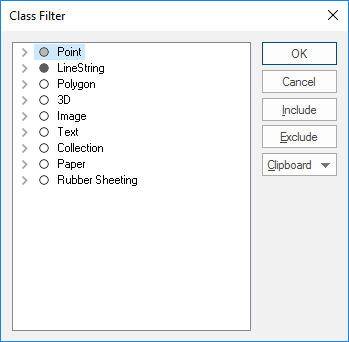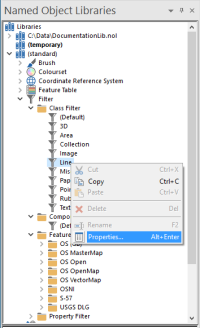Selecting graphic items
You must select graphic items before you can use any edit functions.
To do this use the Select / Select All options. Find allows you to find items in a number of different ways. You can define:
- an expression to find items with particular values for properties
- a Filter
- a geometry test - e.g. you can find items that overlap the selected Polygon item
- a Spatial Filter
Items that meet your specifications are selected.
You can combine geometry tests, filters, spatial filters, and expressions in any combination.
Using items to find and select items
The Geometry tab of the Find dialog (Home > Selection) allows you to use existing items to select other items applying any of a number of tests.
This command allows all OGC geometry relationships to be tested.

- Check the The currently selected item(s) must... tickbox.
- Either check the all… tickbox so that all of the selected items have to pass the test or leave it blank for one selected item to be enough.
- Choose the selection criteria.
The tests which conform to standard OGC specifications are below:
Geometry tests for finding items
The currently selected item(s) must...
Check this tickbox if the only items that pass a geometrical test are to be selected.
The tests use the OGC "relate" function. This measures the dimensions of the nine intersections formed between the interior boundary and exterior of the two items being compared.
The different tests have different rules for which dimension matrices are valid.
all: Check this tickbox if all the selected items have to pass the test or uncheck if any one is enough.
| Option | Description | |
|
contain |
Their interior is completely inside the selected item. |
|
|
be disjoint from |
They are completely separate from the selected item and their boundaries do not touch. |
|
|
intersect |
If they have a point in common with the selected item (they must not be disjoint). |
|
|
cross |
LineString items will be found if they intersect the selected item without being tangential. Other items will be found if their interior intersects with the interior of the selected item and the selected item goes outside the found item. |
|
|
be equal to |
If their geometry is the same as that of the selected item. |
|
|
overlap |
If the selected item is a LineString item, another LineString item will be found only if the two LineString items are tangential and if neither contains the other. With other item classes, an item will be found only if its interior intersects with that of the selected item, and neither contains the other. |
|
|
touch |
If its interior is disjoint from that of the selected item and if their boundaries intersect. |
|
|
be within |
If the interior of the selected item falls completely within it. |
|
|
be crossed by |
LineString items will be found if they intersect the selected item without being tangential. Other items will be found if their interior intersects with the interior of the selected item and the found item goes outside the selected item. |
|
...the... of the found items
| Option | Description | |
|
origin |
Tests the origin of each SWD item against the current item(s). This lets you speed up the test. |
|
|
extents |
Tests the origin of each SWD item against the current item(s). This lets you speed up the test for complex items. An item’s extents are considered to be a notional rectangle drawn to encompass the item. This rectangle is as small as possible but still contains the entire item. |
|
|
geometry |
Completes a full geometry test. This is the slowest yet most accurate mode. |
|
Using a spatial filter to find and select items
A Spatial Filter allows you to limit which items are selected based on their position relative to the spatial filter.
Using an expression to find and select items
An expression can simply be a property (for instance, you could just select items with a certain feature code using the Feature Code property (_FC&)), or it can use a property or combination of properties in a mathematical or logical operation.
The following are some examples of expressions you might use to select graphics:
|
To select |
use the expression |
|
only Building Outlines (Feature Code 1) |
_FC&=1 |
|
all items except Road Centrelines (Feature Code 98) |
_FC&<>98 |
|
only Building Outlines (_FC&=1), House Numbers & Building Names (_FC&=1006) and Road Centrelines (_FC&=98) |
(_FC&=1) or (FC&=1006) or (_FC&=98) |
|
all items except Building Outlines (_FC&=1), House Numbers & Building Names (_FC&=1006) and Road Centrelines (_FC&=98) |
(_FC&<>1) and (_FC&<>1006) and (_FC&<>98)
|
|
only those Building Outlines which are closed plus all other items except Road Centrelines. |
(_FC&<>1) and (_FC&<>98) everything which is not Feature Code 1 or 98 |
|
only Point items which fall within those container items called Polygons. |
(FindContainer("Polygons")._id&<>0) and (_class$="Point") |
Using filters to find and select items
A filter allows you to base the selection process on the class of item (on features, on item properties or a combination of these).
When an edit filter is applied (on the Filter tab of the Find dialog) the items filtered out are still displayed but cannot be selected (they act as if they had been demoted to visible status).
TIP: Filters are named objects, stored in libraries and can be accessed on the Libraries Control Bar. You can also create your own filters. These same filters can also be applied to selecting which items are displayed on screen.
Types of filter
To include or exclude entire classes of items If you want to exclude an entire item class from being selected or conversely limit the selection process to just one item class (such as all Text items or all Polygon items), use the Class-based Filter.
To include or exclude certain feature types To exclude an entire feature type from being selected or limit the selection process to include one feature type only, use the Feature filter.
This filter can be based on the feature types of many different datasets (e.g. TIGER/Line95, Meridian, etc.). It can also be used to include or exclude items with no feature code.
To include or exclude items based on their properties If you want to include or exclude items on the basis of a property value, use the Property filter.
For instance, you could limit the selection process to only those items whose pen is Green. Properties can also be combined in expressions.
To include or exclude items by combining filters Use the compound filter option to combine other filters.
Filters in the (standard) library
SIS Desktop 9 comes supplied with many filters already created. These are stored in the (standard) library and are read-only.
The standard filters are listed in the Libraries Control Bar.
Selecting the filter and using the local command Properties... allows you to see exactly what each filter includes or excludes.
The following Class Filter dialog shows the details of the filter called Line. Only LineString items, Link items, Line Text items and some Paper and Rubber Sheeting items are included. All other items are excluded:

Applying edited filters
You can apply any of the filters supplied in the (standard) library or any you have created yourself and stored in an editable library. Or you can copy an existing filter and paste it into an editable overlay to alter it.
Creating your own filters
Note: See also Creating Filters.

